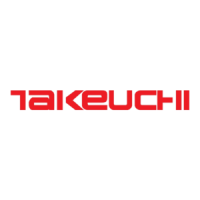FUNCTION
CONTROL VALVE
3
3
CONTROL VALVE 3J0AX00
Port relief valve
The port relief valve is located between the actuator and
the tank circuit T. It protects the actuator from pressure
shocks caused by the sudden blocking of the actuator
port or by overloading, or absorbs abnormal pressure
generated by an external force.
The relief valve is subjected to the relief operation:
As long as the pressure in the circuit is lower than the set
pressure, the relief valve will maintain the pressure equi-
librium and remain shut off. The hydraulic pressure from
the pump passes from the chamber B through the orifice
of the piston (4) and on until it reaches the chamber C
and the needle valve (5).
Meanwhile, the forces F and F1 act on the sides of the
main poppet (6) as indicated by the arrows.
F = P × A
F1 = P × A1 (P: Pressure, A and A1: Cross-sectional ar-
eas)
The cross-sectional area A1 is larger than the cross-sec-
tional area A, which causes the main poppet (2) to be
pushed to the left seat surface by the force of F1 - F.
If the pressure in the circuit becomes higher than the
force of the spring (7), the needle valve (5) is pushed to
the right by hydraulic pressure, connecting the high-
pressure area with the tank passage T. The oil then flows
around the circumference of the needle valve (5) and
passes through the slits, flowing into the tank passage T.
When the needle valve (5) is pushed to the right, which
connects the high-pressure area with the tank passage
T, the pressure behind the piston (4) drops; consequent-
ly, the piston (4) is pushed to the right and up against the
needle valve (5). As a result, the flow of oil from chamber
B to chamber C is cut-off, and the pressure in chamber
C drops.

